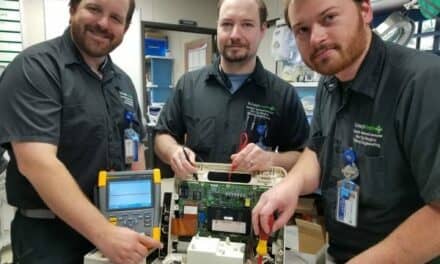By Barry Voss
In today’s hospitals, there are many options for managing medical equipment repair and maintenance, in order to provide the clinicians with the best solutions for providing quality care to their patients.
But consider a case where we have equipment manufacturer No. 1 needing to integrate with equipment manufacturer No. 2, and manufacturer No. 1 says, “here’s what we’ve got,” and No. 2 says, “here’s what we need,” but that’s as far as they go. Now, we could try to hire a third-party service provider to handle the installation, but many would say that they are unauthorized to connect equipment No. 1 to equipment No. 2. Or, we could try hiring a consulting firm, but high costs and strict regulations make that idea a simple no-go.
That is where the hospital’s biomed department comes in. We get things done, because we are not modifying equipment, or inventing new processes, or any of that other stuff. We are just doing our jobs. We get equipment No. 1 connected to equipment No. 2, and everyone is happy. (Sometimes it’s rewarding to be the responsible one.)
Of course, a lot of equipment is connected to a computer network these days. Sometimes outside companies work with the hospital IT department to make sure everything works properly, but when that doesn’t happen it is the biomed department that becomes the interface. We know the system, we know the people to contact, and we know how to get it done. We do other things that no other outside entity will do. If a manufacturer finds a problem, they will fix it, or report it, depending on their scope of responsibility. If a third-party company discovers a problem, they will do the same. If a consultant finds a problem, it will be reported, and then it ends. In a lot of these cases, however, it is the biomed who will take responsibility and actually fix the thing that needs to be fixed.
What’s more, the in-house biomed knows every department, the key players, how to talk to them, and we are there every day. If we see an IV pump on a roll-around stand being pushed down the hall by a clinician with the power cord wrapped around the wheel and almost cut in half, then just a simple, “Hey, listen, that’s broken. It needs to go to biomed right now,” is usually all it takes, because they are our co-workers and they trust us.
As in-house biomeds, it is our job to get along with our vendors and our IT department as well, in order to accomplish the higher goal of providing our customers (the medical staff) with the tools they need to do their jobs. The doctors and nurses and all of the other clinicians know they can depend on us. Biomeds fix things. Sometimes, that’s by using our screwdriver on a piece of equipment. Sometimes, that’s by using our telephone to ask the manufacturer or someone else what’s wrong. By listening and talking to the end user. we can tell them what they have done wrong. The internet can be pretty useful, too. There are many other scenarios, but when we find something wrong, these are common tools used to fix a problem.
Since the late 1970’s, I’ve been hearing about the paperless office, where everything will be will be run by computers; that didn’t happen. There are more authorization forms and reports, and you name it than ever before—and they are all printed out on paper. Nowadays, it’s all about remote-service to diagnose problems with medical equipment from the manufacturer. That did happen, kind of. Once the manufacture’s remote-service is connected via computer and the diagnosis has started, however, there still needs to be a human to push another button to get to the next set of results. And that human is, you guessed it, the in-house biomed. We know what button to push and when to push it. Or, of course, you can wait until next Tuesday, or possibly Thursday, for the field service people to show up.
Barry Voss has been a biomed since the 1970s. From Yale-New Haven Hospital to California to Saudi Arabia he has worked in biomed, nuclear medicine, ultrasound, and CT. He now works as a biomed in the U.S. The views expressed are solely those of the author. For more information, contact [email protected].




Nice article